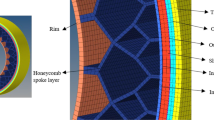Abstract
This research aimed to develop a dynamic finite element (FE) model of non-pneumatic tire (NPT) to study the mechanical behaviors of rolling NPT. The generalized Maxwell’s viscoelastic material was combined with linear elastic material model. This material model was fitted with results of tensile and compressive testing on actual NPT specimen. The FE model of rolling NPT on curvature and flat surface under supporting load of 14 kN and speed of 11 km/hr were carried out to compare with the actual experiment of rolling NPT on drum testing machine. The high-speed video camera was used to capture NPT’s spoke deformation at various angular position corresponding to time. The comparison results shown good agreement between the actual experiment and both FE models, which yielded average error of 3.68 and 3.89% for FE model of rolling NPT on drum and flat surface, respectively. The maximum dynamic values of impact force, displacement, and stress were higher than static values of 1.06, 1.16 and 1.805 times, respectively. Finally, the limitation of rolling NPT’s performance on flat plate was analyzed. The shear stress between shear band and spoke under maximum load of 20 kN and velocity of 15 km/hr was found at 1.7277 MPa.
Similar content being viewed by others
References
Aboul-Yazid, A. M., Emam, M. A. A., Shaaban, S. and El-Nashar, M. A. (2015). Effect of spokes structures on characteristics performance of non-pneumatic tires. Int. J. Automotive & Mechanical Engineering 11, 1, 2212–2223.
Chung, J. and Hulbert, G. M. (1994). A family of single-step houbolt time integration algorithms for structural dynamics. Computer methods in applied mechanics and engineering 118, 1–2, 1–11.
Gasmi, A., Joseph, P. F., Rhyne, T. B. and Cron, S. M. (2012). Development of a two-dimensional model of a compliant non-pneumatic tire. Int. J. Solids and Structures 49, 13, 1723–1740.
Gent, A. N. and Watler, J. D. (2006). The Pneumatic Tire. National Highway Traffic Safety Administration. Washington DC. WA. USA.
Jin, X., Hou, C., Fan, X., Sun, Y., Lv, J. and Lu, C. (2018). Investigation on the static and dynamic behaviors of non-pneumatic tires with honeycomb spokes, Composite Structures, 187, 27–35.
Ju, J., Veeramurthy, M., Summers, J. D. and Thompson, L. (2013). Rolling resistance of a nonpneumatic tire having a porous elastomer composite shear band. Tire Science and Technology 41, 3, 154–173.
Kim, K., Heo, H., Uddin, M. S., Ju, J. and Kim, D.-M. (2015). Optimization of nonpneumatic tire with hexagonal lattice spokes for reducing rolling resistance. SAE Paper No. 2015-01-1515.
Phromjan, J. and Suvanjumrat, C. (2018a). A suitable constitutive model for solid tire analysis under quasi-static loads using finite element method. Engineering J. 22, 2, 141–155.
Phromjan, J. and Suvanjumrat, C. (2018b). Material characteristic for capability analysis of solid tire by finite element method. Key Engineering Materials, 777, 416–420.
Phromjan, J. and Suvanjumrat, C. (2018c). Material properties of natural rubber solid tires for finite element analysis. Key Engineering Materials, 775, 560–564.
Rhyne, T. B. and Cron, S. M. (2006). Development of a non-pneumatic wheel. Tire Science and Technology 34, 3, 150–169.
Rhyne, T. B., Cron, S. M. and Pompier J. P. (2006). Compliant wheel. US7013939.
Rugsaj, R. and Suvanjumrat, C. (2018a). Determination of material property for non-pneumatic tire spokes by inverse method. Key Engineering Materials, 777, 411–415.
Rugsaj, R and Suvanjumrat, C. (2018b). Finite element analysis of hyperelastic material model for non-pneumatic tire. Key Engineering Materials, 775, 554–559.
Rugsaj, R. and Suvanjumrat, C. (2019). Proper radial spokes of non-pneumatic tire for vertical load supporting by finite element analysis. Int. J. Automotive Technology 20, 4, 801–812.
Veeramurthy, M., Ju, J., Thompson, L. L. and Summers, J. D. (2014). Optimisation of geometry and material properties of a non-pneumatic tyre for reducing rolling resistance. Int. J. Vehicle Design 66, 2, 193–216.
Yoo, S., Uddin, M. S., Heo, H., Ju, J. and Choi, S. J. (2017). Thermoviscoelastic modeling of a nonpneumatic tire with a lattice spoke. Proc. Institution of Mechanical Engineers, Part D: J. Automobile Engineering 231, 2, 241–252.
Acknowledgement
This work was financially supported by Rubber Technology Research Center (RTEC), Mahidol University and the Thailand Research Fund (TRF) under the TRF Research Grant No. RDG60T0140.
Author information
Authors and Affiliations
Corresponding author
Additional information
Publisher’s Note
Springer Nature remains neutral with regard to jurisdictional claims in published maps and institutional affiliations.
Rights and permissions
About this article
Cite this article
Rugsaj, R., Suvanjumrat, C. Dynamic Finite Element Analysis of Rolling Non-Pneumatic Tire. Int.J Automot. Technol. 22, 1011–1022 (2021). https://doi.org/10.1007/s12239-021-0091-6
Received:
Revised:
Accepted:
Published:
Issue Date:
DOI: https://doi.org/10.1007/s12239-021-0091-6




